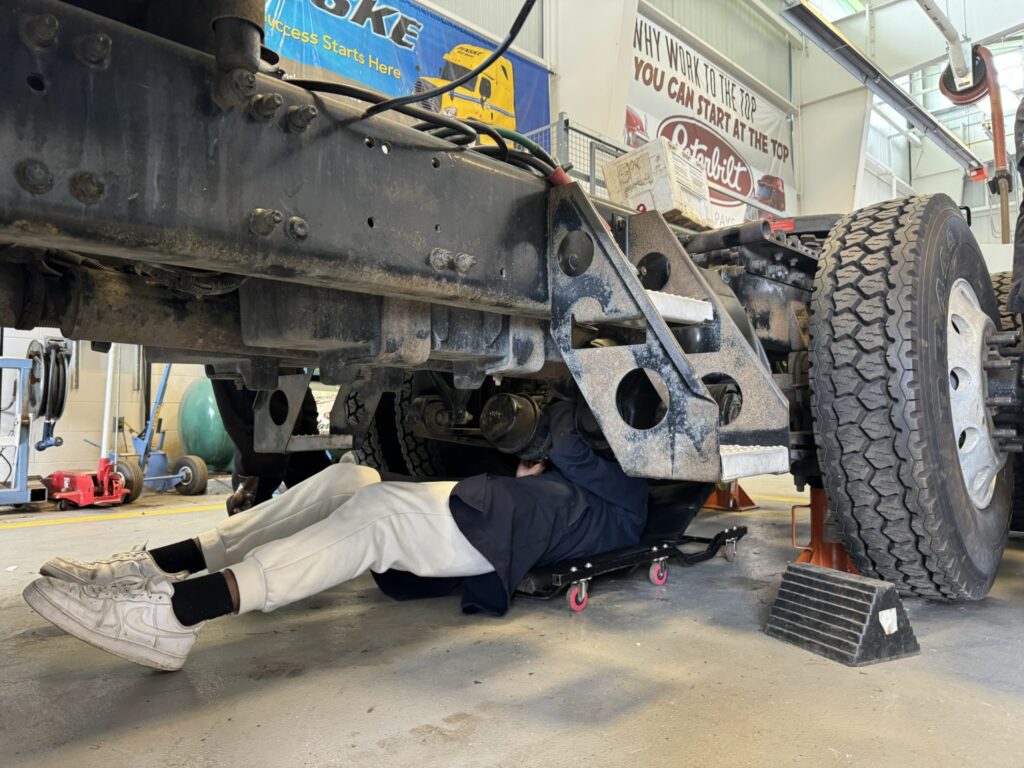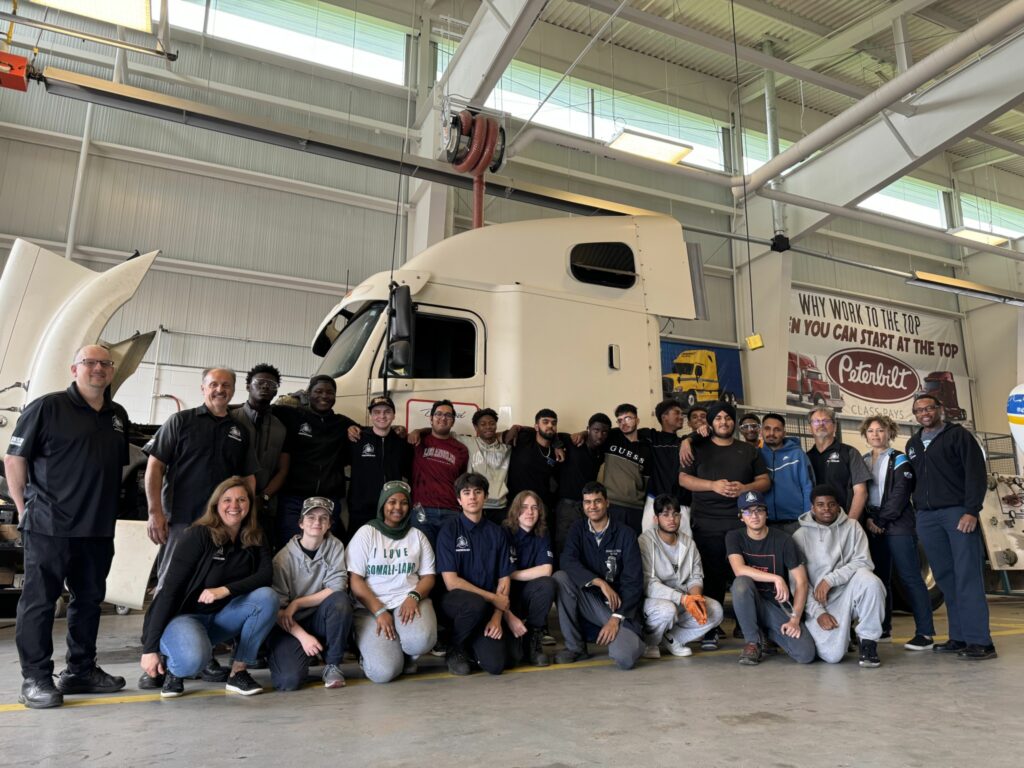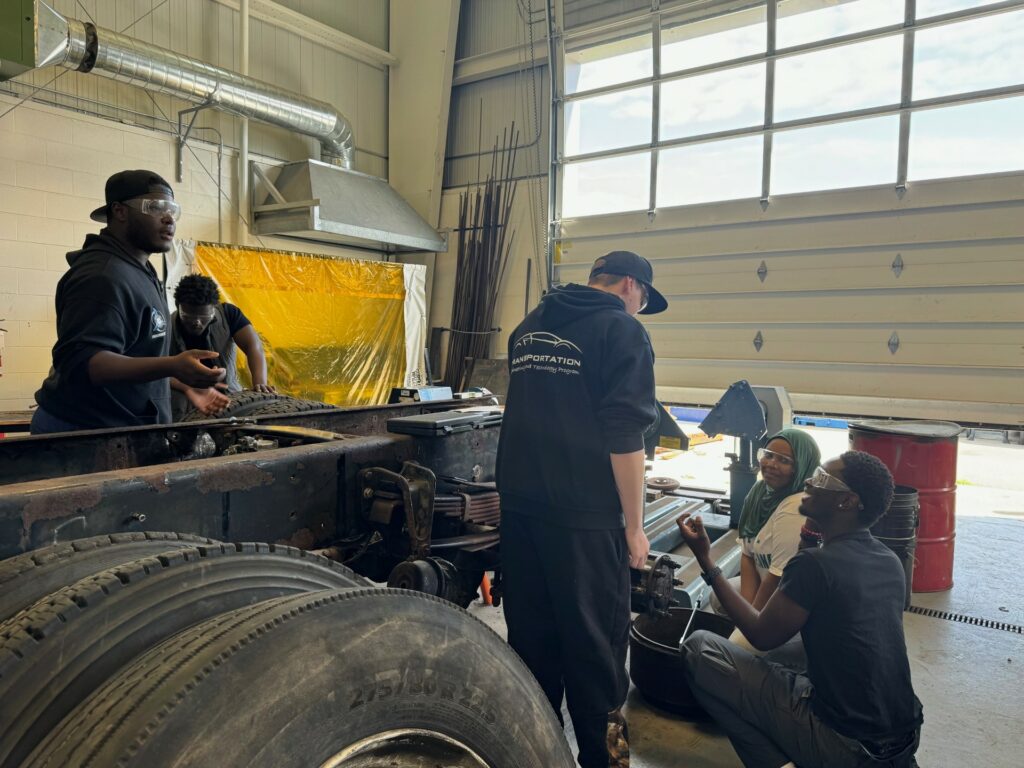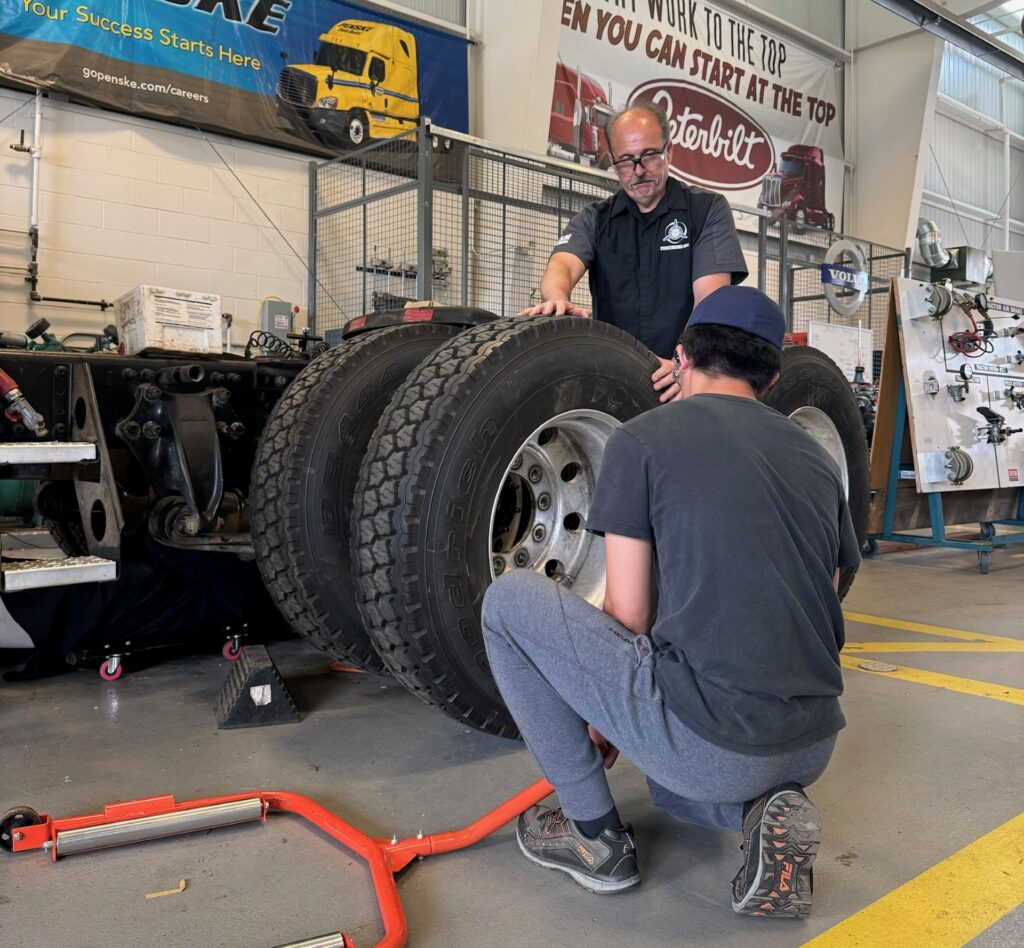Sukhman was drawn to the world of trucking since he was 14 years old, as his passion was ignited by family ties and his school’s transportation program.
“I knew that I wanted to be in this industry as I had pretty big plans,” he says.
Currently in Grade 12 of Bramalea Secondary School in Brampton, Ont., Sukhman is completing a co-op at a Kenworth dealership as a part of his Specialist High School Major program in transportation. He describes the dealership as his favorite place due to the extensive learning opportunities it presents.
There, he delves into engine work, diagnostics, wiring, and pre-delivery inspections. After graduation, Sukhman hopes to get a full-time job and keep learning until he becomes a senior tech. “Within three or four years [after that], I want to learn everything there is to know about it, and then have enough knowledge to eventually start my own business and open a shop,” he says.
Sukhman is one of many students who have gone through the regional transportation program offered at Bramalea Secondary, which started 12 years ago with truck and coach training and was rebranded several years ago.

It is now dubbed the Regional Transportation and Engineering Technology program and it prepares students in Grades 9 and 10 to complete the Specialist High School Major program in transportation throughout Grades 11 and 12, familiarizing them with the marine, aerospace and land transportation industries.
This technical program accepts about 42 students per year, who are divided into two tech classes of 21 students. To be eligible for the program, applicants must meet certain criteria including academic marks, skills, and pass an interview process that assesses their interest in the field.
But Bramalea’s head of the technology department, Derek Holseth, adds that to encourage more participation from underrepresented groups, the school board has implemented special admission criteria. If applicants self-identify as African, Black, First Nations, Inuit or Métis, and meet criteria for admission, they are automatically granted an offer to the join the program.
Is trucking popular?
However, this is not a journey without bumps on the road.
“One of the hurdles was trying to show parents and students, especially at Grade 9, that this is it’s actually a good industry to be in,” says Eugene Odoardi, one of the transportation teachers. “When you say trucking coach, a lot of parents look at it, [saying], ‘Oh, it’s a dirty industry,’ or, ‘I don’t really want my child getting into this.’ But when you introduce it as a transportation industry, now they are saying, ‘OK, well, there’s a lot of opportunities here.’ And then once they get in, they see that the trucking coach industry really isn’t a dirty industry.”

Connor and Nefi, both Grade 12 students who are currently completing their co-op at the Rush Truck Centre in Mississauga, Ont., say trucking was not among their career choices prior to enrolling in the program.
“I grew up liking cars and was used to working on things. I was always like, ‘Oh cars, I gotta work on cars.’ But I didn’t even think of the fact that these trucks need to be worked on, too,” recalls Connor. “In the program, you hear a lot about it. But outside of the program, no one really talks about it that often.”
Nefi had a similar experience. He got into the program because he is a hands-on person who always loved taking stuff apart and putting it back together, but he was always intrigued by the auto industry.
“But as soon as I learned more about the truck and coach industry, I kind of went off,” he says.
Ontario Youth Apprenticeship Program
While the regional program exposes students equally to different aspects of transportation, including marine, land, and aero transport, about half of the students graduate with more interest in trucking, and the rest pursue careers in the automotive and aerospace industries, says Elizabeth Helme, Bramalea’s co-op teacher.
Students also have a chance to apply to take part in an accelerated OYAP (Ontario Youth Apprenticeship Program) that is run in collaboration with schools like Centennial College.
“[Students] will get their 310-T Level 1 [apprenticeship] by the time they’re 17,” says Helme. Usually, this program takes eight weeks, but it is spread out for students over several months, running from January to June.
She explains that on Fridays, Centennial instructors come to the school to teach the theoretical components. And then on Monday, students take a bus out to the Scarborough campus to apply theory to practice. And from Tuesday to Thursday, they continue their apprenticeship at their current job placements.
Thriving on partnerships
Prior to the Covid-19 pandemic, the program, which relies heavily on community support, had strong industry partnerships, said Holseth and Helme. According to them, nearly 80% of all the equipment in the shop is donated by industry players like Penske, Peterbilt, Kenworth, Thermo King, and others.
Meanwhile, local shops and fleets like Bison, Midland, and smaller local companies, helped by accepting co-op students. Some, says Helme, ended up hiring the students after graduation. For example, she recently got in touch with a former student who has been at Bison for nearly four years.
Odoardi recalls that prior to the pandemic, Cummins also partnered with the school. Two licensed certified technicians would come to the shop weekly to work with students.
“Unfortunately, that kind of fell apart during Covid,” he says. “Making those connections again is taking a little more time now.”
But cultivating relationships can be done in several ways, says Holseth. One key aspect is securing co-op placements for students. Building awareness about career opportunities is a crucial part of the program, too. Students start at around 12 years old and grow up in the program, graduating at 17 or 18 years of age.

“Part of that growing up is learning about career opportunities, like where do they excel and where are they going to benefit society,” he said, further noting that supporting the community fund with donations can facilitate student advancement into trades through scholarships for apprenticeship achievement or entry into trade industries.
“These funds help students to take the next step,” Holseth said, adding it assists with purchasing tools, educational expenses, transportation, and other necessary costs as students transition into the trade.
Donations needed
Partnerships also involve inviting guest speakers and providing students with up-to-date training. This may not always involve acquiring new equipment directly; sometimes it’s about demonstrations or field trips to facilities.

Community partners might support the program by donating training modules and equipment.
Transportation teachers, Odoardi and Tony Martini, are currently seeking donations of small and medium-duty engines and essential components to enhance their high school training programs.
Both teachers say four-cylinder diesel engines suitable for the young learners, as well as engines from medium-duty trucks, like Hino or Isuzu, are on their wish list.
Martini adds that components such as starters, alternators, wheel-ends, and air brake system parts, which undergo frequent use and need regular replacement to keep up with rigorous educational use, are also essential for the curriculum.
Staying current
As technology and tools evolve as well, the call for updated equipment becomes ever more significant, as employers look for skilled talent familiar with the latest equipment.
For example, Connor said that one thing that surprised him at the co-op placement was the extent of computer usage to run reports on trucks, check for diagnostic codes and identify potential issues.
“We use a computer on every truck at least once,” he said. “I figured it would be hands-on heavy work, but not so much anymore, just because of where the industry is now.”
Such ‘health checks’ are something students, too, get into in Grade 12, explains Odoardi, adding that while they try updating the computer they have as much as possible, there is not much left to do when the hardware gets old. For example, its last scanning tool was bought seven years ago.
“Everything starts at safety, and it ends and safety. The everything in between is really the bonus.”
Tony Martini
But being tech-savvy is not the only thing that matters. For some time now, the industry has been putting more emphasis on the safety aspect of the job. And Helme says many employers that provide co-ops for Bramalea students are impressed with the training they receive.
“Any module or any activity they do in the shop or in the classroom, it always starts from a safety aspect,” says Martini. “Even if they’re a Grade 12 student, and it’s their last week, if they’re doing something that doesn’t meet our safety requirements, we stop them immediately. So, everything starts at safety, and it ends with safety. The everything in between is really the bonus.”
Odoardi shares that earlier in his career, he had his own shop and also worked as a trainer for Shell Canada where he developed safety training, saying he transferred all his knowledge into the program.
Any equipment that gets installed at Bramalea’s shop goes through a ‘rigorous’ safety inspection by the school board and safety protocols are set in place for tech courses.
The school also provides them with safety training for various certifications like CPR (Cardiopulmonary Resuscitation) and first response, as well as out fall protection, lockout tagout, and more.
Learning process
At the time of our visit to the school, Grade 11 students were working in a shop with Odoardi. He told TruckNews.com that most recently, the students have been learning about air brake systems, the AC air circuits, and foundation brakes.
“They learned the foundation brakes, and basically, they jacked the truck up, they blocked it, hold the wheels, pulled the drums, removed the whole brake assembly, and then they did a brake inspection,” he explained. “Now, they’re reinstalling everything. So, they’re going to put all the brake system back together, put the wheels back on the truck, and put the vehicle back down.”
The teachers use a blend of instructional videos and live demonstrations to teach students before allowing them to work on vehicles, but many of these students are much better hands-on learners than they are visual learners, Odoardi observes.
However, some students grasp the theory in the classroom, but feel overwhelmed during the practical part. In such cases, teachers are available to work with these students a little more and assist them should they have any difficulties.
The mixed delivery really does work for the kids. Several students that are currently in their co-ops say they are well-prepared for the job and say the program has given them a head start in their careers.
“It really helps you find what your passion is [and] it really hones out what trade you want to go into. It just like really helps you in deciding what you want to do as a career,” Nefi said.
